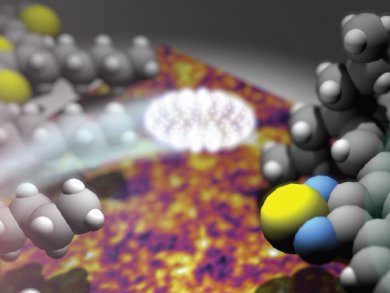Fullerene derivatives have been explored as n-type acceptors for solar cells but are limited by their low absorption in the red region. Non-fullerene-based small molecule acceptors have been investigated by Paul Meredith and co-workers, University of Queensland, Australia. They report that 2-[{7-(9,9-di-n-propyl-9H-fluoren-2-yl)benzo[c][1,2,5]thiadiazol-4-yl}methylene]malononitrile can be processed in solution to give thin films suitable for solar cell applications. Annealing at a modest temperatures gave films with greater order and enhanced charge transport properties.
The molecule can efficiently quench the photoluminescence of the donor polymer poly(3-n-hexylthiophene-2,5-diyl) – over 90 % efficiency at concentrations lower than 2 % (by wt.). This is greater than the common fullerene alternative, [C60]PCBM, at similar molar concentrations.
Image: (c) Wiley-VCH
 A Small Molecule Non-fullerene Electron Acceptor for Organic Solar Cells
A Small Molecule Non-fullerene Electron Acceptor for Organic Solar Cells
P. E. Schwenn, K. Gui, A. M. Nardes, K. B. Krueger, K. H. Lee et al.,
Adv. Energy Mater. 2011, 1, 73-81.
DOI: 10.1002/aenm.201000024



